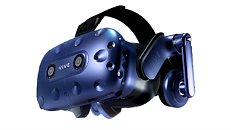Developers at SteamVR have announced a new feature called Motion Smoothing that will enable "more players on more PCs to play high-fidelity VR games and experiences". This technique works in a similar way to what it does on flat screen TVs. In this case, Motion Smoothing interpolates between two existing frames and creates a new in-between frame that smooths the experience and increases framerate. That adds latency, which is not a good idea in VR experiences, and that's precisely what's different at SteamVR implementation.
With that feature enable, SteamVR detects when an application is going to drop frames. If that happens, "it looks at the last two delivered frames, estimates motion and animation, and extrapolates a new frame. Synthesizing new frames keeps the current application at full framerate, advances motion forward, and avoids judder". This allows the user to enjoy full framerate while the performance requirements decrease. That way, even users with graphics card not specially powerful can still enjoy VR experiences without problems.



In the announcement Valve developers focus on Vive and Vive Pro and they confirm that with this new feature users can enjoy games running smoothly at 90 Hz. Even lower-end GPUs will allow to get nice VR experiences previously available only on expensive, higher-end GPUs. The technology is available in the Beta Program of SteamVR and requires an NVIDIA GPU. It won't be enabled on Oculus Rift or Windows Mixed Reality Headsets, though, "because their underlying display drivers use different techniques when applications miss framerate".
View at TechPowerUp Main Site
With that feature enable, SteamVR detects when an application is going to drop frames. If that happens, "it looks at the last two delivered frames, estimates motion and animation, and extrapolates a new frame. Synthesizing new frames keeps the current application at full framerate, advances motion forward, and avoids judder". This allows the user to enjoy full framerate while the performance requirements decrease. That way, even users with graphics card not specially powerful can still enjoy VR experiences without problems.



In the announcement Valve developers focus on Vive and Vive Pro and they confirm that with this new feature users can enjoy games running smoothly at 90 Hz. Even lower-end GPUs will allow to get nice VR experiences previously available only on expensive, higher-end GPUs. The technology is available in the Beta Program of SteamVR and requires an NVIDIA GPU. It won't be enabled on Oculus Rift or Windows Mixed Reality Headsets, though, "because their underlying display drivers use different techniques when applications miss framerate".
View at TechPowerUp Main Site




 .... the PSVR was the worst device I tried for giving me motion sickness so sold it oculus rift was better but still left me feeling ill. it would last for days were I would be feeling sick lol but I still love the tech, shame i cant use it
.... the PSVR was the worst device I tried for giving me motion sickness so sold it oculus rift was better but still left me feeling ill. it would last for days were I would be feeling sick lol but I still love the tech, shame i cant use it 
